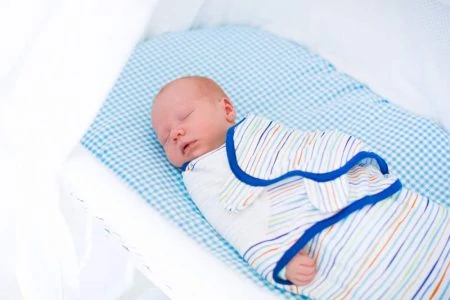Swaddling is a lifesaver for new parents. It mimics the womb, prevents the startle reflex, and helps everyone get a few hours of precious sleep. I remember the nurse teaching me the “burrito wrap” technique; I thought I’d use it forever.
But there comes a time when the swaddle has to go. Whether for safety reasons or because your baby is ready for more freedom, transitioning away from the swaddle is a major milestone.
If you are dreading the transition, don’t panic. We will cover exactly when to stop swaddling and how to do it without wrecking your sleep schedule.
Key Takeaways
- Safety first: You must stop swaddling the moment your baby shows signs of rolling over, which usually happens between 2 and 4 months.
- Watch the signs: If your baby breaks free consistently, fights the swaddle, or the Moro reflex disappears, it is time to transition.
- Go gradual: Ease into the change by leaving one arm out for a few nights, then both arms, before removing the swaddle entirely.
- Use tools: Transitional products like sleep sacks or the Zipadee-Zip can bridge the gap between swaddling and sleeping freely.
When to Stop Swaddling Baby
Knowing when to stop is partly about intuition, but mostly about safety. While every baby develops at their own pace, the American Academy of Pediatrics (AAP) suggests stopping as soon as your baby shows signs of trying to roll over (1).
Here are the three main signs it is time to unwrap your little one.
1. They Start Rolling Over
This is the most critical sign. Swaddling becomes dangerous once a baby can roll over. If a swaddled baby rolls onto their stomach, they cannot use their arms to push up or turn their head, which significantly increases the risk of SIDS and suffocation (2).
Most babies start attempting to roll between 2 and 4 months. Even if they haven’t fully flipped yet, if you see them rocking side-to-side or kicking their legs over, it is time to stop swaddling immediately.
2. They Break Out Constantly
If you wake up every morning to find your baby has busted out of the swaddle, it might be time to move on. While you can try swaddling tighter, a baby who consistently fights their way out is telling you they want more freedom.
Loose blankets in the crib pose a safety hazard (3). If the swaddle won’t stay secure, it becomes a loose bedding risk.
3. The Startle Reflex Fades
The main point of swaddling is to suppress the Moro reflex (the startle reflex), which causes babies to jerk their arms and wake themselves up. This reflex typically disappears between 3 and 6 months.
If your baby sleeps soundly without flinching when you lay them down unswaddled, they no longer need the physical containment of the blanket.
How to Stop Swaddling
Deciding to stop is the easy part; getting your baby to sleep without it is the challenge. You generally have two options: cold turkey or a gradual wean.
Going cold turkey is faster but often results in a few rough nights of crying. A gradual approach is usually gentler on everyone.
Here is our recommended step-by-step method for weaning off the swaddle:
- One Arm Out: Start by swaddling your baby with one arm left free, while keeping the torso and other arm wrapped. Do this for 3 to 4 nights so they get used to having a hand available for self-soothing.
- Both Arms Out: Once they adjust, leave both arms free but keep the swaddle wrapped snugly around their chest and belly. This provides that familiar pressure without restricting movement.
- Ditch the Swaddle: Finally, remove the swaddle blanket entirely. At this point, you should switch to a wearable blanket or sleep sack to keep them warm without loose bedding.
Trust your gut during this process. Some babies adjust in a few days, while others need a couple of weeks.
Best Transition Products That Help
If your baby is struggling to sleep without the tight wrap, you don’t have to suffer. There are several transitional products designed specifically to bridge the gap between a tight swaddle and a loose sleep sack.
These tools can help dampen any remaining startle reflex while keeping your baby safe and warm.
1. Sleep Sacks
Once the swaddle is gone, you cannot use loose sheets or comforters in the crib. Sleep sacks are the standard replacement. They are essentially wearable blankets that zip up over your baby’s pajamas.
They come in various materials (cotton, fleece, muslin) and thermal ratings (TOG), ensuring your baby stays at a safe temperature without the risk of kicking blankets over their face.
2. Baby Merlin Magic Sleepsuit
The Magic Sleepsuit is a cult favorite for a reason. It is a thick, stiff suit that looks a bit like a space suit. The thickness provides a muted sensory input that muffles startle reflexes and makes the baby feel held.
Important Note: This product is for back-sleeping only. Once your baby can roll over in the suit, you must stop using it. It is a great temporary tool for the 3-to-6-month window.
3. Anna & Eve Swaddle Strap
If you are worried about overheating or just need to transition slowly, the Swaddle Strap is an excellent option. It wraps only the arms and chest, leaving the hips and legs completely free.
This is ideal for babies who need upper-body containment but hate having their legs confined. It includes an inner strap to prevent the fabric from sliding up over the baby’s face.
4. Zipadee-Zip
The Zipadee-Zip became famous on “Shark Tank” and is arguably the best option for babies who have already started rolling. Its starfish design encloses the hands and feet but allows full range of motion.
Because the baby can push up and roll over safely while wearing it, you can use it longer than a traditional swaddle. The slight resistance in the wing-tips helps soothe the startle reflex without restricting movement. It is safe for sleeping, strollers, and car seats.
5. White Noise
If your baby is waking up more often after dropping the swaddle, environmental noise might be the culprit. Without the physical security of the wrap, babies become more sensitive to sounds.
A white noise machine creates a constant background hum that mimics the sound of blood rushing in the womb. This can help lull them back to sleep through sleep cycle transitions.
6. A Consistent Sleep Routine
Babies thrive on predictability. If you are taking away the comfort of the swaddle, replace it with a rock-solid bedtime routine.
Whether it is a bath, a book, or a lullaby, doing the same steps in the same order signals to your baby’s brain that it is time to sleep. This psychological cue can be just as powerful as the physical cue of the swaddle.
Warning
FAQs
In Conclusion
The transition away from swaddling can feel daunting. We get it; nobody wants to mess with a sleeping baby! But remember that this is a sign of healthy development. Your baby is getting stronger, more mobile, and ready for the next stage.Be patient with the process. You might have a few nights of disrupted sleep, but your baby will adjust. Stick to your routine, keep safety top of mind, and soon enough, your little one will be sleeping soundly with their arms free.






